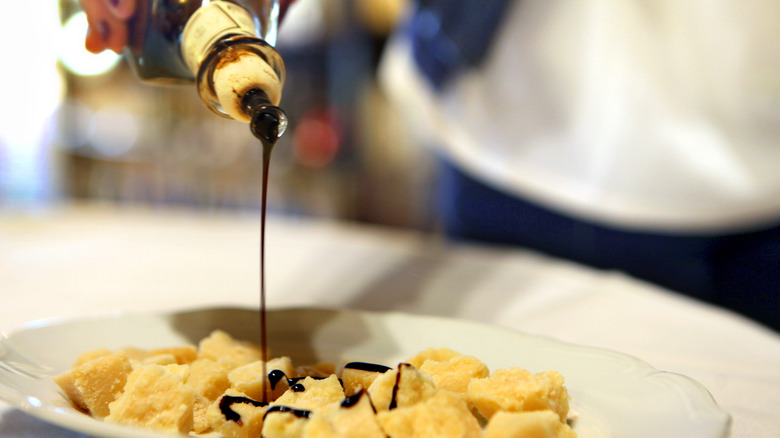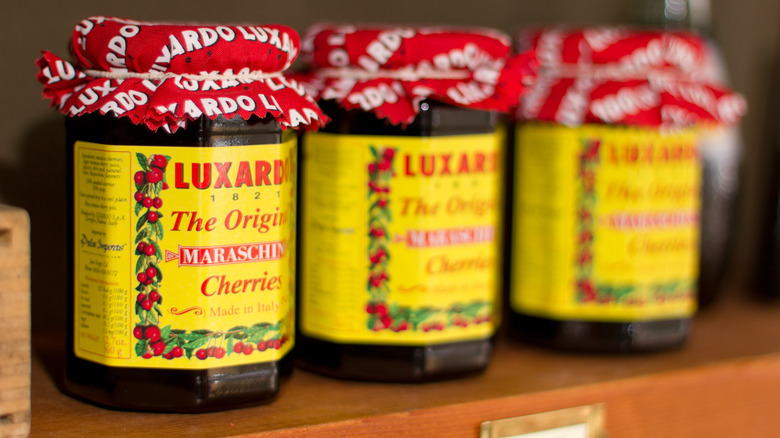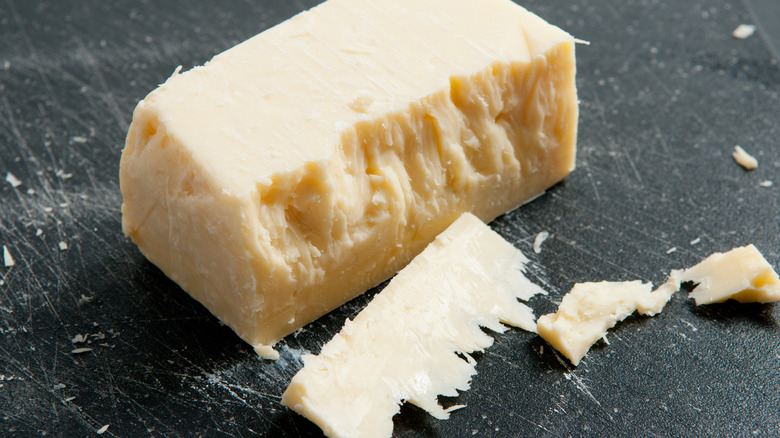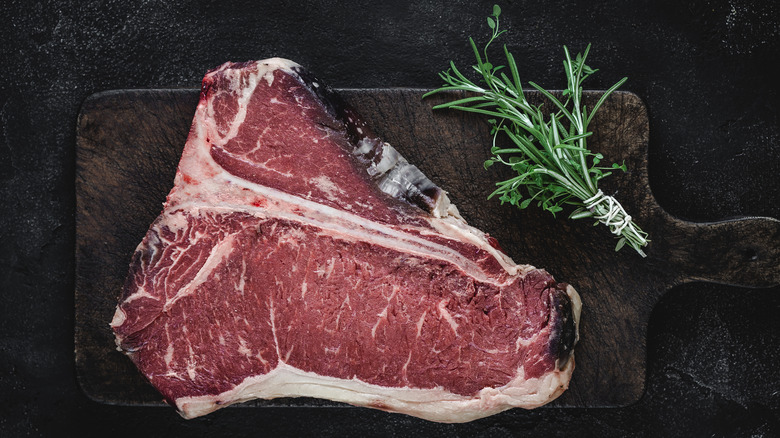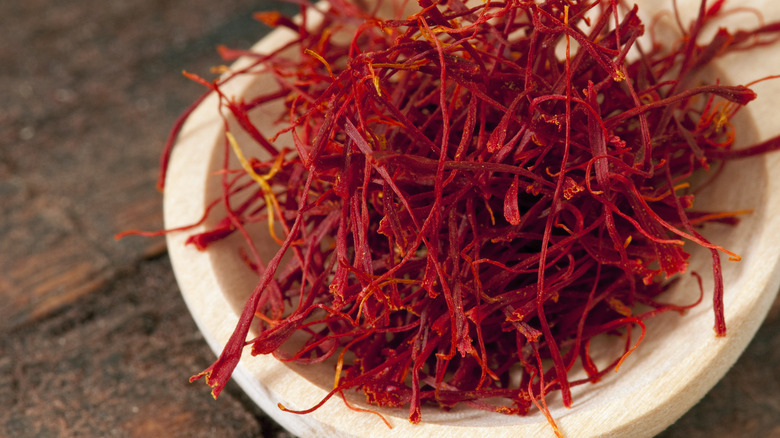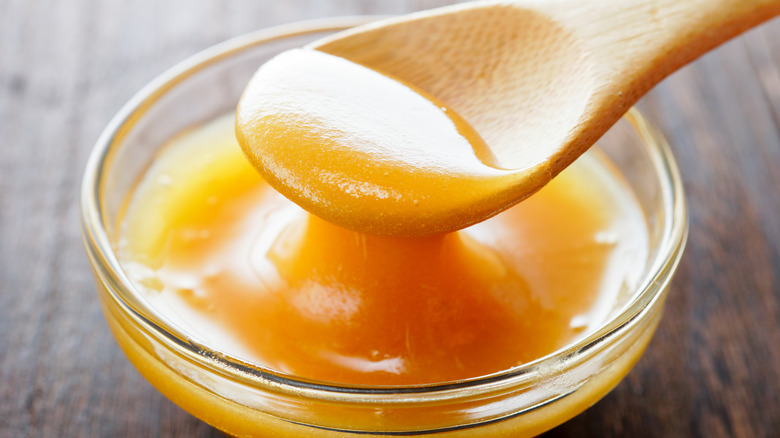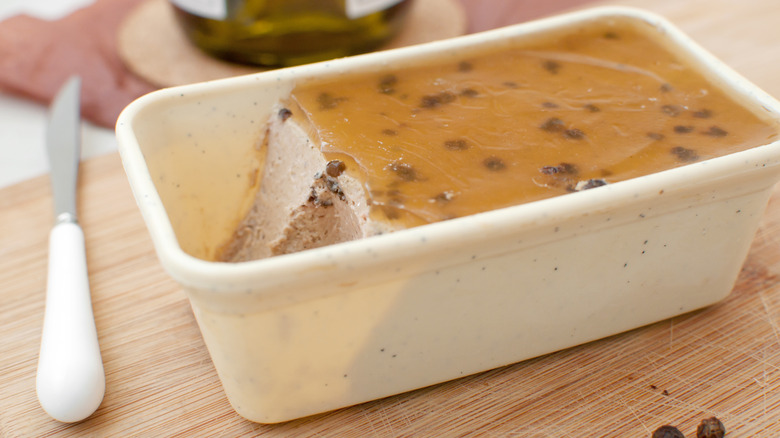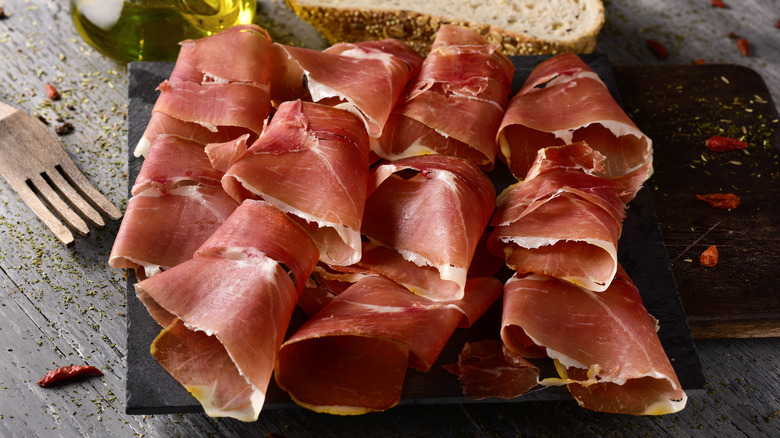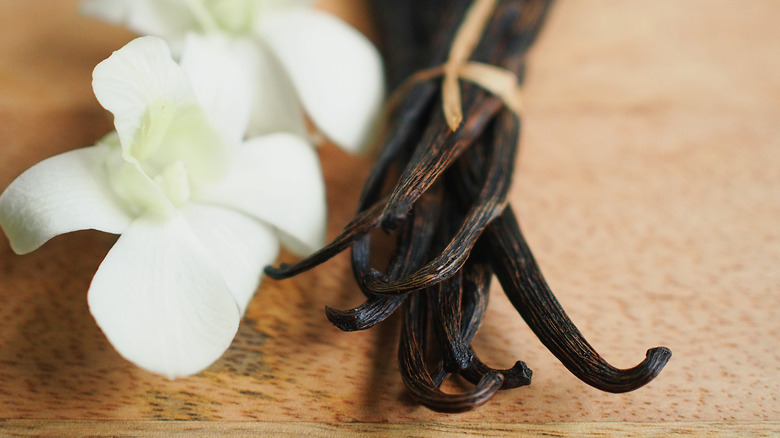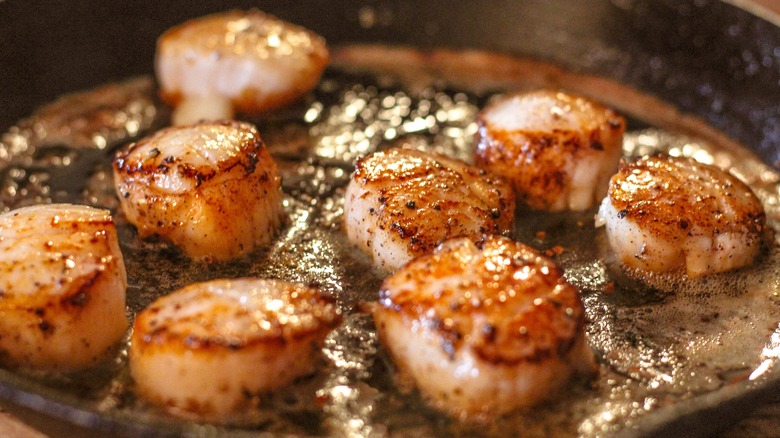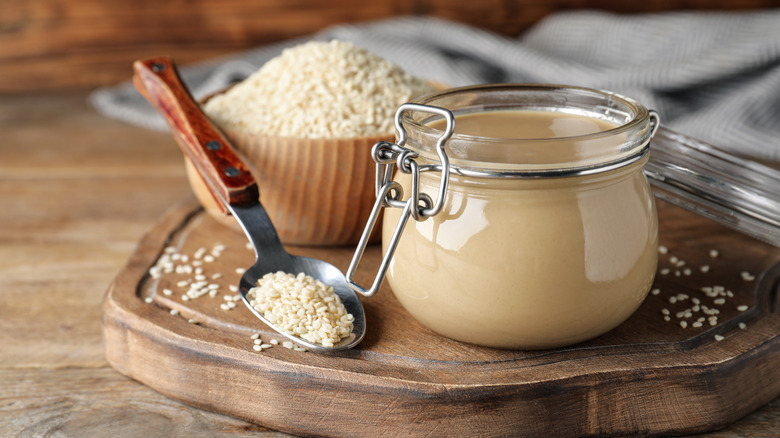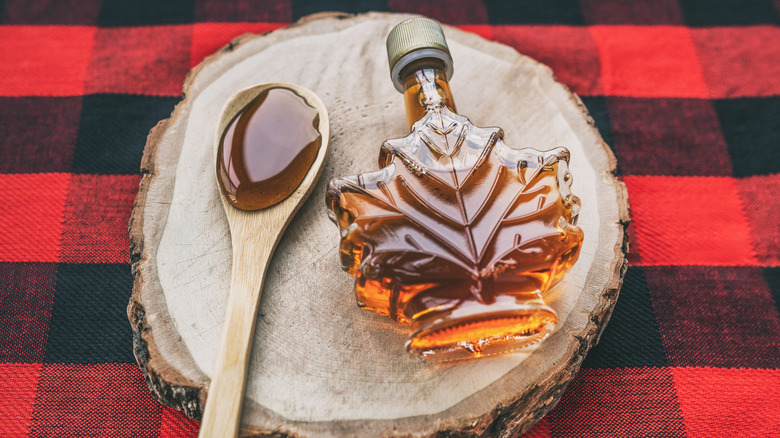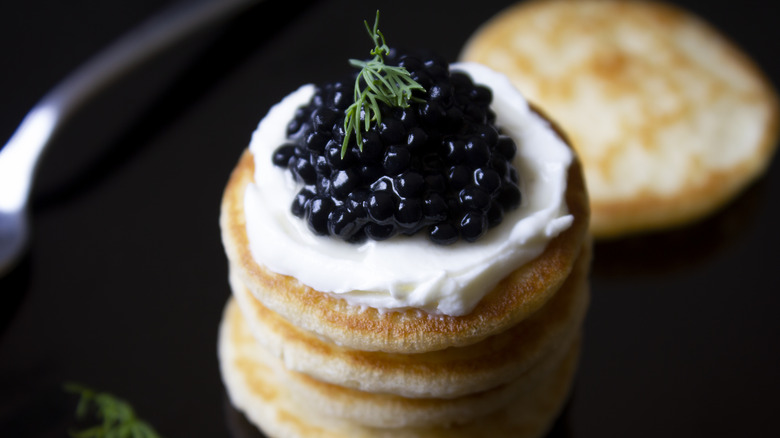Splurge-Worthy Grocery Store Items You Should Try At Least Once
Even better than wondering what you would do if you won the lottery, is knowing exactly what you would do with a baller grocery store gift card. Bust out the fancy napkins because these splurge-worthy goodies are worth trying at least once.
We tapped full-blooded culinary pleasure-seekers for this one, sourcing the best tips and tricks to really get our money's worth when we're going all out. No expense is too expensive, and no luxury is too luxurious. You should be able to find a version of these items at your local supermarket. Of course, if your neighborhood grocery store is the notoriously high-end Round Swamp Farm in the Hamptons, you might need a bigger platinum card.
From sweet, aged balsamic vinegar to drizzle over a Caprese salad, to the juiciest maraschino cherry to drop into a Manhattan, and a superfood honey to dazzle that cheese board, this one's all about the finer things in life. Grab a reusable tote and put on your "inside sunglasses" — we're going shopping like we own the place.
Aged balsamic vinegar
This is the difference between salad dressing and the essence of the gods. Aged balsamic vinegar is worth the higher price point because of its mind-blowing flavor profile — and the fact that it goes on just about anything (even ice cream).
The traditional aging process starts with pure grape must which spends a whole bunch of its life in wooden barrels. In Modena, Italy, "Affinito" balsamic is aged for a minimum of 12 years, and "Extra Vecchio" balsamic gets the 25-year treatment. The pièce de résistance is a DOP-certified bottle that's guaranteed to be authentic (with the red wax-sealed top). We'd also settle for an IGP-certified bottle verifying the grapes used, and Modena-based processing. It's the kid who didn't turn in all of his homework by the end of the semester but still got a solid A-minus.
Aged balsamic is smoother, richer, less acidic, and sweeter than regular balsamic, and features earthy, woody, fruit-like flavors from the barrel it's aged in. Even people who might not be into regular balsamic typically enjoy its cool older sister. Some 25-year-old bottles are gonna cost ya upwards of $100, but younger 12-year-old bottles land squarely in "got it, gonna buy it" territory, at around $40.
High-end maraschino cherries
Okay, no, we're not talking about those neon red cherries, bless their little artificial hearts. We're going for a vibe that's less "clown nose on a whipped cream-faced pancake," and more "mysterious stranger at the other end of the bar" — with high-end maraschino cherries.
The difference in taste alone makes these cherries worth shelling out roughly $20 for a jar. For example, they taste like actual cherries. Plus, they don't go through the same process that the unnaturally pink cherries do. In case you were wondering, that typically involves a six-week bleach, followed by a month-long sugar, syrup, flavoring, and red dye soak. Finally, they're stemmed and pitted, and pumped with even more sugar and preservatives so they don't turn to complete mush after all of that.
Luxardo Original Maraschino Cherries feature a tart Morello cherry variety, covered in a deep red syrup made of marasca cherries. The fruit is smaller, darker, and candied in a way that keeps its fresh crunch — even if it just spent the last hour sitting on the bottom of your glass.
Aged cheddar cheese
Everything old is delicious — especially when it comes to cheese. And while we could happily fall headfirst into a fully-fromage display case, living there for the rest of our days, there are a few varieties that we wouldn't want to miss as a daily shopper. At the top of the list? Aged cheddar cheese.
Leave those rookie Kraft singles in the dust, and go for a cheddar that grows a little hair on your chest (uh, so to speak). Fresh, young cheddar tastes creamy and smooth, and we almost fell asleep just thinking about it. Awesomely crumbly aged cheddar is wham bam thank you ma'am with a flavor that's nuttier and sharp as a paper cut. Pricing here will hit all over the board thanks to a variety of ages and origins (moo, eh?), but generally, you'll be looking for something that hits at roughly $15 on the low end. It sure beats a $4,000 wheel of Parmigiano Reggiano DOP, just saying.
Cheese Brothers put out a 15-year reserve aged cheddar that was meant to be enjoyed by itself or with, like, a delicate sliver of apple. The Carr Valley Cheese company ages its cheddar inside an actual cave to give it an earthy tang that compliments a crisp apple cider. And Gardner's Wisconsin Cheese serves up an ancient 17-year-old super sharp cheddar that goes great with a glass of Champagne. Bottoms up — you'll never go back to normal cheddar again.
Dry-aged steak
Why eat regular beef when you could sink your teeth into an age-old steak that's been hanging around for 30 days? Dry-aged beef has been on trend for years, but dry aging is actually a tenderizing method that goes back to the 17th century.
Where modern meat purveyors find convenience with the much-faster wet aging process, dry aging (allowing the meat to cure in the open air, at a regulated temperature, in controlled environments) adds deep umami flavor. This creates an unmistakable contrast against the metal or sour taste of younger, wet-aged beef. Also during the dry aging process, moisture is pulled out of the beef and redistributed back into it to offer the most tender bite.
The price point will vary based on the cut of the meat, as well as the length of time it's been aged (usually somewhere around 30 days). You might find a dry-aged ribeye for $25 to $40, a dry-aged New York strip for $60, or (calling all ballers) a Wagyu dry-aged tomahawk ribeye for roughly $150. A word to the wise, dry-aged steak packs less moisture than fresh cuts do, so it can overcook in a matter of seconds. Keep a close eye on the grill, and err on the side of taking it off the heat too early, rather than too late.
Real saffron
You may have picked up a bottle of saffron and wondered if there's even anything in it (are we hallucinating, or is that a tiny red thread for $50?). That's exactly the vibe we're looking for. Except we want to make sure you're spending your cash on an authentic version of the spendiest spice in the world.
The saffron flavor profile is almost as delicate as the spice itself. The sometimes nutty, floral, earthy, sweet, or grassy aromas lend dimensional flavor to dishes like chicken tagine, risotto, and rosewater and saffron ice cream — which is delicious sprinkled with roasted pistachios and served in between Persian bastani-e nooni wafers like an ice cream sandwich.
Other than an oddly low price tag, another way to spot fake saffron on the shelf is in the shape of the threads (bring your magnifying glass). Real saffron should be bigger at one end, like a trumpet. Imitation threads are not. Once you get home, you can also try soaking a few threads in hot water for 15 minutes. Real saffron will gradually dye the water yellow, while the threads keep their shape and red hue. Fake saffron threads will lose their color and disintegrate completely. If you see the good stuff, it's worth the extra dough.
Raw manuka honey
It suffers from way-over-hypedness, but Manuka honey kicks all the other kinds of honey to the curb. Its powerhouse nutrition hikes up the price — but no pain, no gain when it comes to shopping like Gwyneth Paltrow. Think of it almost like a multi-talented petroleum jelly that you can also eat. Rich and almost toffee-like, it's still sweet, but not face-smackingly sugary. Manuka honey can do everything from soothing a scratchy throat to calming an upset stomach and bolstering your immune system — thanks to its hefty helping of the antibacterial compound methylglyoxal (MGO). It packs many more anti-inflammatory and antimicrobial properties than regular honey, and it's even been known to support the regeneration of tissues.
While some Manuka honey brands can ring up at more than $200, you don't need to go gangbusters to get the benefits. Look for MGO numbers printed on the packaging (the higher the number, the more nutritional benefits it has). Every day Manuka should hit somewhere around 50+ MGO. "I don't have time to get a cold right now" special-use manuka will hover around 700+ MGO or higher. You might also see a Unique Manuka Factor (UMF) rating, too. That means the product is guaranteed to be genuine New Zealand manuka honey — with a rating that fluctuates based on the honey's MGO score. Get a jar and drizzle it over that aged cheddar cheese.
Truffle mousse
From the bottomless category of truffle stuff, we have distilled this earthy flavor down to the one most likely-to-be-at-the-store item. Truffle mousse packs all the bells and whistles of that truffle life into a velvety spread that's delicious on everything — potato chips with ridges, seedy crackers, crusty baguette, you name it.
Truffle mousse is a light and airy cousin of pâté that's usually made of a creamy blend of chicken and turkey livers, wild mushrooms, black truffles, butter, and maybe a sherry wine. It's then seasoned with garlic, onions, and rich spices. We like brands that are minimally processed and as close to nature as possible. And, because this is essentially foie gras blended with truffles, we also look for humanely raised animals so we can enjoy this decadent treat with zero guilt.
While a pound of fresh white truffles can bust the bank at $7,000, truffle mousse typically clocks in at around $15 to start, going up from there. We love it to zhuzh up a charcuterie board or as a schmear on toast for breakfast. Ooo, what about a truffle mousse sandwich — or truffle mousse pizza? Can't stop, won't stop — all truffle everything.
Jamón Serrano
When it comes to the finest specialty foods, it seems like you can't go wrong with jamón anything. While we'd push old ladies out of the way for a slice of paper-thin, melt-in-your-mouth jamón Iberico right off the leg, it's not the easiest treat to find. That's where jamón Serrano fills in as a total winner.
Jamón Serrano is dry-cured ham from Spain with a deep, savory, and smoky flavor, that packs a bit more chew than prosciutto di parma, or your run-of-the-mill deli ham (don't worry, it's nowhere near jerky territory). Prosciutto pigs munch on corn, fruit, and whey, where white Serrano hammies love oak tree acorns, and mushrooms, grass, and herbs in warmer months. That particular diet affects the signature Serrano flavor.
Grab jamón Serrano for a quick snack on its own, or pair it with slices of a fresh baguette, or even a cheese platter with olives and pickles. You should be able to find jamón Serrano starting around $12 and skyrocketing from there. If you happen to spot this little piggy's fun cousin, sliced Iberico jamón de bellota (it's darker, more flavorful, fattier, aged longer, and definitely spendier), it's guaranteed to be one you'll want to text home about.
Madagascar vanilla
Still in a relationship with imitation vanilla? Ghost the fake stuff, and step out with authentic Madagascar vanilla. This isn't exactly one of those snacks you pick up and then guzzle down in the parking lot. But once you bake with it, you'll realize what you've been missing. Real. Vanilla. Flavor. Sweet and velvety Madagascar vanilla makes quite a journey from field to bottle, which is the reason for the, "Does this have diamonds in it or something?" price point. Farming starts by hand-pollinating a single vanilla orchid, which blooms for only 24 hours, and then grows one vanilla bean six months later. We're exhausted just thinking about it.
The rich vanilla flavor is what makes this the deal of a lifetime. Imitation vanilla typically tastes like one thing: basic vanilla. But Madagascar vanilla features notes of tobacco, florals, fruit, and maybe a little spice on the back end. True vanilla extract is also made with no less than 35% alcohol (we didn't decide that, the FDA says so). Look for Nielsen-Massey Madagascar Pure Bourbon Vanilla Extract for around $20, just about anywhere there's a glimmer of a baking aisle. You also might be able to snag two vanilla beans from the brand for $25, or even the vanilla bean paste for $5 more. That next batch of brownies is gonna be the bomb-dot-com.
Sea scallops
Ah, the pencil erasers of the sea. When they're good, they're great — even with just a quick sear and some salty butter. But while they're easier to find than say, Norwegian langoustines, you still want to get the best bivalves available (yikes, that sounds impersonal. We'll call them Chuck and Sharon).
If you see dry-packed scallops, go for those over wet-packed. Dry ones are packaged with zero additives and preservatives, and they don't lose their water when they're cooked. They also won't shrink down after hitting the heat and are usually sustainably sourced. According to the National Oceanic and Atmospheric Administration, sea scallops that have been wild-caught in the Atlantic are an ocean-friendly bet, typically ranging in price from $20 to $75 for these buttery beauties.
Okay, so what do you do now that you've secured these Chucks and Sharons? Eat 'em. Not to be a basic Karen (no offense, Karens!), but pan-seared scallops in a buttery garlic and lemon sauce might be our favorite recipe in the world. Ooo, maybe some capers in there, too. Did someone say to serve them over linguini? We're in.
A nice bubbly
Quench your sparkling thirst with a bubbly that's worth the hundo. But especially when you're handing over your hard-earned cash for a top-shelf bottle, you want to be sure you're gonna enjoy every last drop.
Maybe you're a sparkling rosé type, a brut reserve brunch bruh, or you only drink the stuff with the yellow label from Madame Clicquot. Whatever type of glass you toast with, we're here to sip it straight — no mimosas.
For something akin to a dry apple cream pie, pluck a chilled bottle of "the holy grail of Champagnes," Krug Grand Cuvée Brut, for about $160. If you're feeling like the sweet kiss of honey, Ruinart Blanc de Blancs 100% chardonnay does the job for under $100. But, if you really came to play, you won't fizzle out with a vintage; particularly, the $550 Dom Pérignon P2 Plénitude Brut Champagne. It's extra-extra aged. Plus, it smells like buttery brioche and fruity florals and goes down warm and smooth like a nutty, spicy dream.
Sesame tahini
It's the peanut butter of the seed world. If you've ever tasted tahini paste made from authentic Ethiopian sesame seeds, you know what level of deliciousness we're talking about. Tahini paste provides the tasty foundation for dippable and drizzle-worthy favorites like tahini dip, hummus, and baba ganoush. Even smoothies, soups, and stews get a boost from a spoonful of the stuff. And while any tahini paste can work for a recipe, only sesame seeds that originate from the tiny town of Humera, Ethiopia truly knock that signature tahini flavor out of the park.
Soom brand tahini hits on the lower end of the tahini-verse, at roughly $10-ish for a jar for their Ethiopian sesame seeds, with a dark chocolate version as well. Seed + Mill offers organic Ethiopian sesame seed tahini for about $15 per container. But if you spot the sampler trio — with 16 ounces each of their original, organic roasted garlic, and organic za'atar tahini — drop what you're doing and give them $42 for the sesame seed experience of your life.
Grade A amber maple syrup
Haters will say it's from the wrong state, but grade-A amber maple syrup is delicious no matter where it's from. This one's a plate-licker, people. And if you spot it on the shelf, pony up, whether it's bottled in the shape of a maple leaf or not.
Specifically, we're on the hunt for "Grade A: Amber" maple syrup. It wins Best Overall in the imaginary category of what can go on pancakes, but also works in granola. It's the rich, golden-hued one, with that signature slightly caramel, kind of toffee-ish maple syrup flavor. Pinky swear, you'll love it.
You might see Grade A Amber Vermont Maple Syrup (in the maple leaf bottle) for $16, with its perfectly iconic branding. Or, maybe a newer scenester like Sapsquatch might have you shelling out $30 for a small jug. There may also be brands boasting bourbon barrel flavors, which easily hike the price into the $40 range. The question remains: Are you ready for the greatest breakfast of all time? A thousand times, yes. If you happen to make eye contact with a limited edition $48 Pappy Van Winkle 23-Year Bourbon Barrel Aged Pure Maple Syrup, screw the waffles. We fully support drinking that one straight out of the bottle.
Sustainably harvested caviar
An arbiter of sophisticated taste, caviar could show up to a party in sweatpants, and things would still get fancier. But with a fluctuating price range landing somewhere in between $25 and $35,000 for an ounce (Gulp! For a second we thought that said $35,000... wait). We want to be well-versed in luxury fish eggs. Or at least pass caviar kindergarten.
Dip a toe in the pool with Echo Falls' $25 Alaskan wild salmon caviar, which packs all the poppable, breezily salty notes, without kicking you in the gut on the price. Or, go middle of the "roe" with a tasting duo like Pearl Street Caviar's $82 Ossetra + Keluga set which lets you sample a Kaluga sturgeon hybrid (aka, "River Beluga" — a sustainable alternative to Beluga caviar), and osetra caviar, which is one of the most coveted in the world for its sturdy beads that taste nutty and briny. Of course, keep an eye out for eco-friendly varieties (or U.S. farm-raised sturgeon). Beluga may boast the most clout, but the fish is also "critically endangered." We prefer to indulge with a clear conscience. Also, we're not sure we could handle caviar prison.


